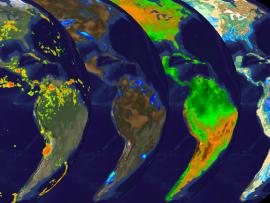Browse energy budget Resources
Browse energy budget Resources
Primary Topic:
Subtopics:
Type:
Standards:
Keywords:
Summary:
In this lesson, students will explore (through labs, videos, and a simulation) how energy from the sun is absorbed, reflected and radiated back out into space as part of the Earth’s energy budget.
Primary Topic:
Subtopics:
Type:
Keywords:
Summary:
Welcome to the Tour of the Electromagnetic Spectrum. This unique NASA resource on the web, in print, and with companion videos introduces electromagnetic waves, their behaviors, and how scientists visualize these data.
Primary Topic:
Subtopics:
Type:
Keywords:
Summary:
Learn how NASA uses a data-collecting sensor, Clouds and Earth’s Radiant Energy System, or CERES, to study clouds and make accurate measurements of energy leaving Earth.
Primary Topic:
Subtopics:
Type:
Keywords:
Summary:
Learn how the greenhouse effect keeps more of the sun's heat and energy within Earth's atmosphere causing temperatures on Earth to rise. This video explains the effect warmer temperatures are playing on Earth.
Primary Topic:
Subtopics:
Type:
Keywords:
Summary:
Learn how scientists use a satellite called CERES to study the clouds and monitor Earth's climate changes.
Primary Topic:
Subtopics:
Type:
Keywords:
Summary:
Explore how water moves across land and returns to the ocean in the final installment of the water cycle series. The visualizations illustrate the movement of water on land—from storage of precipitation in soil layers, to its transport via rivers.
Primary Topic:
Subtopics:
Type:
Keywords:
Summary:
Explore how water droplets form and fall from the sky in part three of the water cycle series. Watch how water vapor moves through the atmosphere and returns to Earth as rain and snow.
Primary Topic:
Subtopics:
Type:
Keywords:
Summary:
Explore water vapor in the air in part two of the water cycle series. This second part of our series on the water cycle illustrates the way in which evaporation and winds combine to move water from the ocean to the land.









